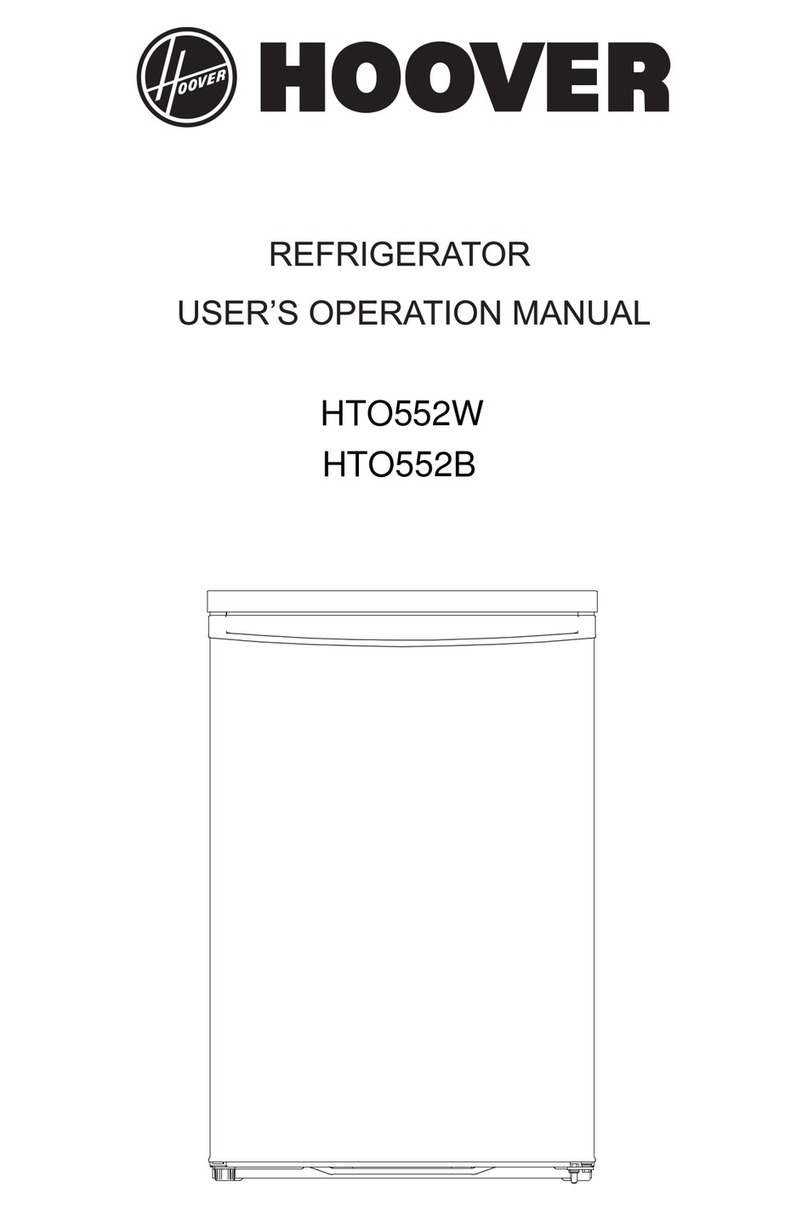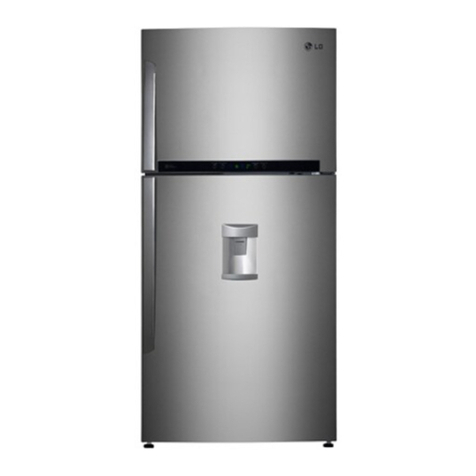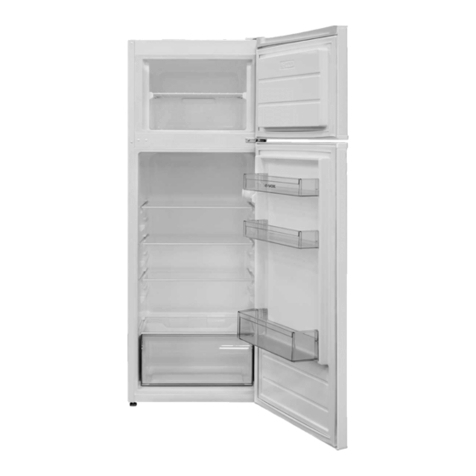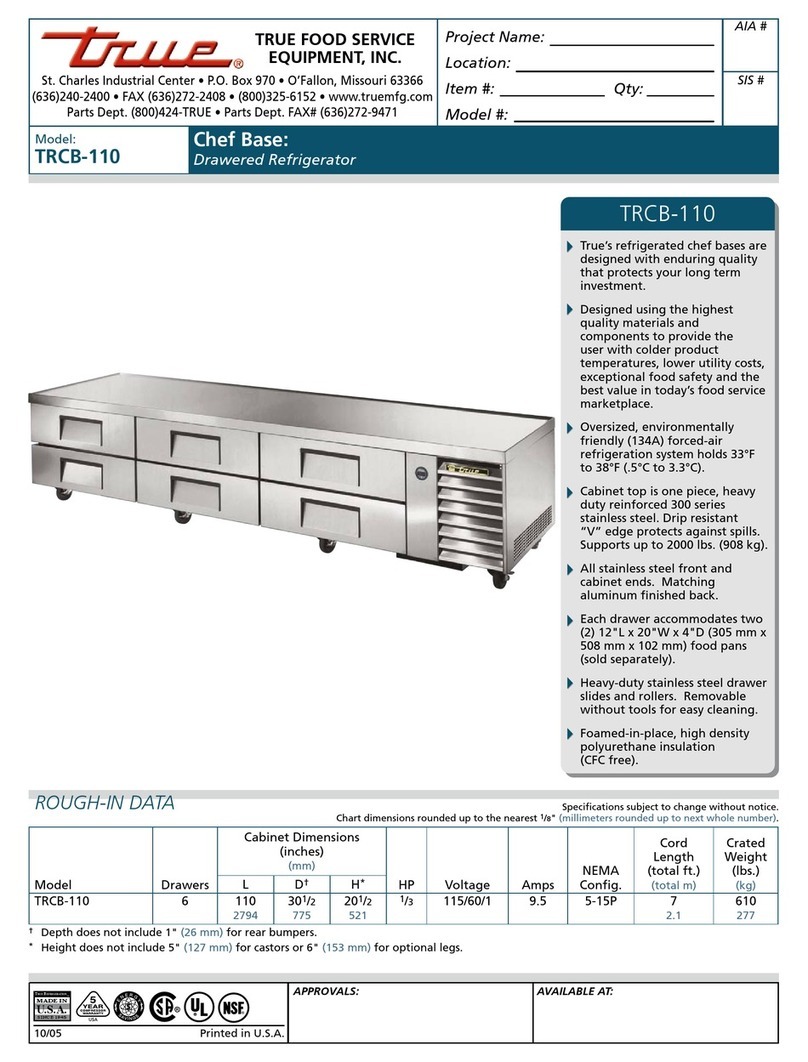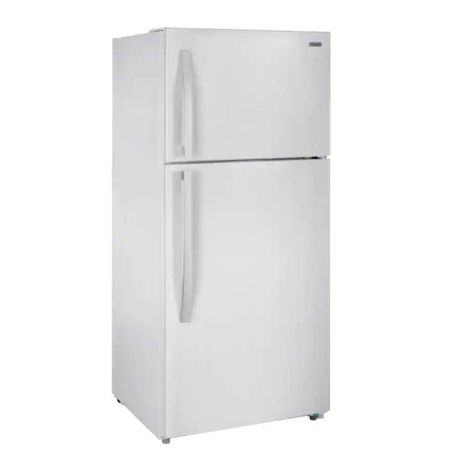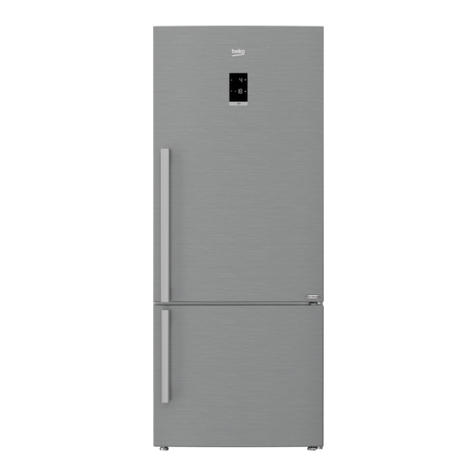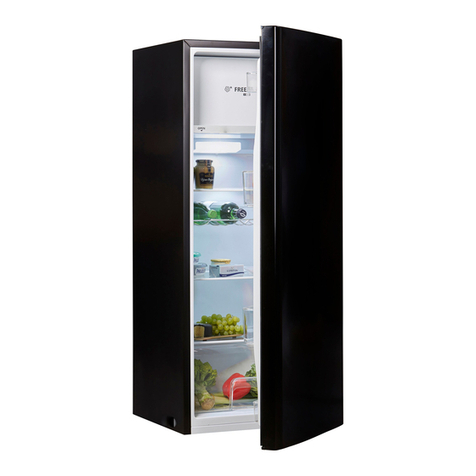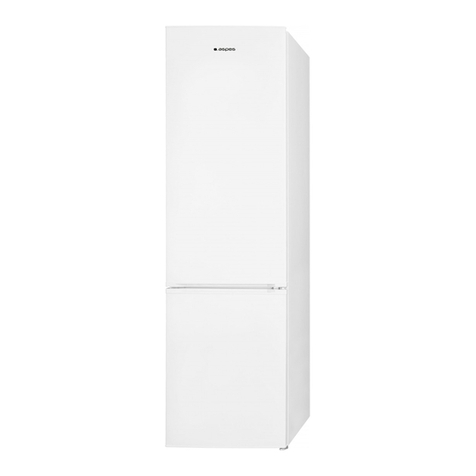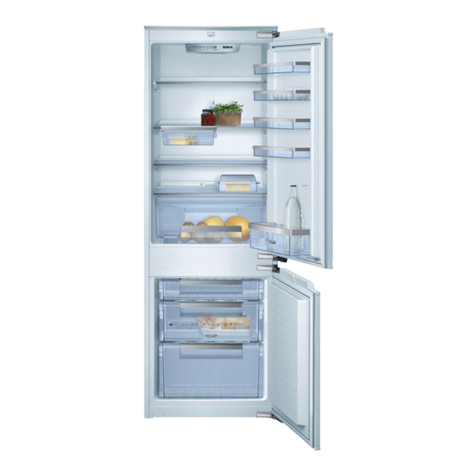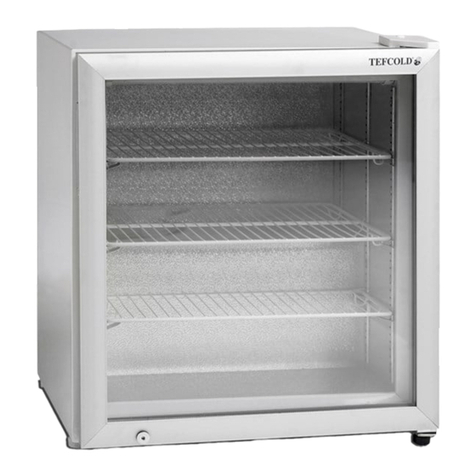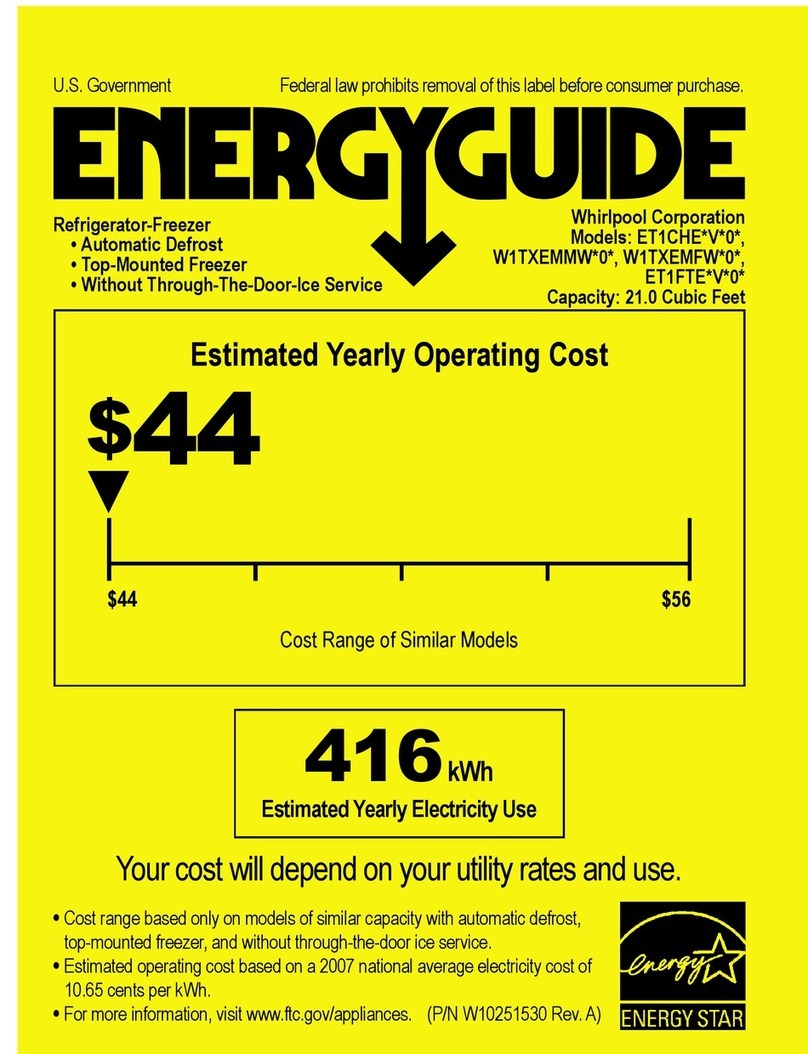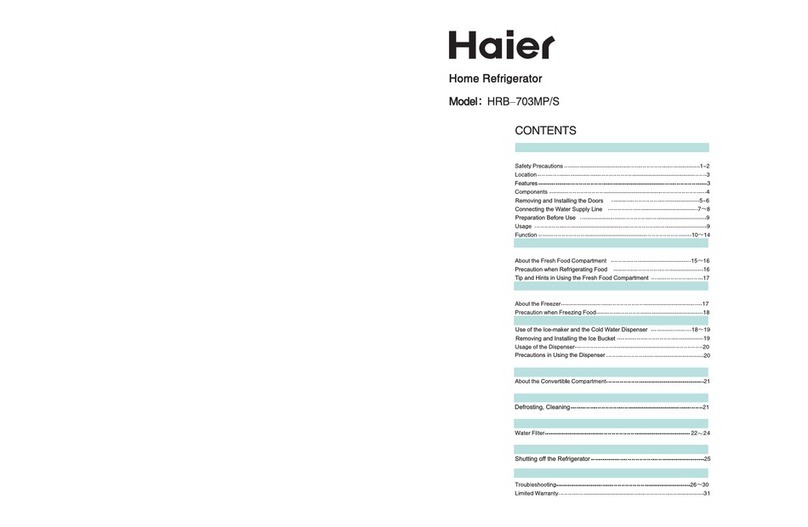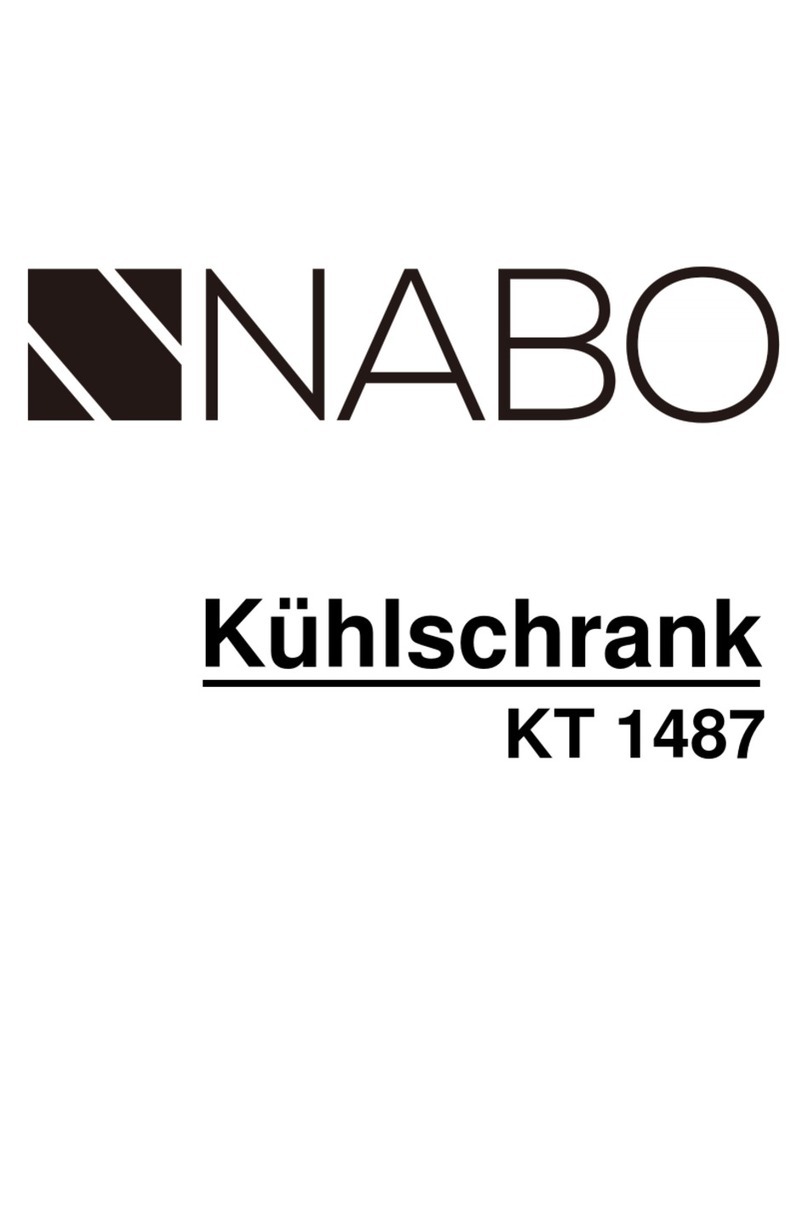DE RIGO refrigeration Eco Madeira M2 User manual

Manual VZST11851
D-G2713
Revision 00
Revision date 11/ 03/ 2013
EURO MADEIRA
USE AND MAINTENANCE MANUAL
Read carefully and preserve together with the counter
(Euro Madeira, Eco Madeira)
EN


3
De Rigo Refrigeration s.r.l.
TABLE OF CONTENTS
General Features ..................................................4
Position of main components........................4
General Description...................................... 5
Serial number plate .......................................5
Important installation conditions............................6
Warnings..............................................................8
Installation recommendations .......................8
General recommendations ............................9
Adjustment ...................................................9
Precautions for use and minor maintenance........10
Loading products for display .......................10
Replacing light bulbs ...................................11
Positioning display shelves..........................13
Night blinds .................................................14
Electric components ...........................................15
Lighting .......................................................15
Electric panels.............................................15
- Dixell PLUG-IN electric panels...................16
Technical information..........................................17
Technical documentation inserted
in counters .........................................................17
Technical data ....................................................18
Emergency situations.................................................... 21
We recommend reading the contents of this manual and keeping it together with the counter. The
manufacturer will not be held liable for property damage and/or personal harm due to failure to comply
with the instructions contained in this manual. It is therefore recommended that whoever uses this
counter carefully read the use and maintenance manual.
The refrigerated counters which the following use and maintenance instructions refer to comply with
Standard ISO 23953-2 - Refrigerated display cabinets - and apply the HACCP Foodstuff and relative
control system safety standards.
The products are manufactured in accordance with the following standards and their specific updates:
EN 60335-2-24 (1994) + A51(’95) + A52(’96) + A53(’97), EN 60335-1 (1988) + A2(’88) + A5(’89) + A6
(’89) + A51(’91) + A52(’92) + A53(’92) + A54(’92) + A55(’93) + A56(’95), IEC 60335-2-24 (1997) + A1
(’98), IEC 60335-1 (1991) + A1(’94)
Description of the product
Installation of the product
Maintenance and use of the product
Lighting and electric controllers which
can be configured on the product
Technical data of the product
Management of emergency situations

4
De Rigo Refrigeration s.r.l.
EURO MADEIRA
GENERAL FEATURES
Madeira is a plug-in refrigerated counter for the display and sale of meat, cold cuts, dairy products, fruit
and vegetables with ISO 23953-2 class 3 climate operating conditions.
The maximum depth of the counter when using 450mm shelves is equal to 850mm and is available in
937, 1250, 1875 and 2500 mm lengths. In addition, it is available in Eco Madeira where a sliding door is
provided that allows good energy savings.
All wall counters in the Madeira range are, furthermore, available in plug-in and remote versions. The
plug-in wall counter is equipped with a compressor and begins operation as soon as the plug is con-
nected to the mains supply, while the counter in the remote version requires connection to the central
refrigerant.
Position of main components
1. Electric panel
2. Serial number plate
3. Equipotential point
4. Access to the condenser for cleaning
3 behind
1
4
2
1(display)

5
De Rigo Refrigeration s.r.l.
General Description
In the PLUG IN version, the wall counter is equipped with a microprocessor controller that carries out
all operations necessary for the proper operation of the wall counter itself. It has 2 relay exits to control
the electric compressor and defrost. It is equipped with two entries for the NTC probes, one inside the
wall counter under the roof, to view the remote display, the other is positioned on the evaporator for
thermostat control and temperature control at defrosting end (refer to pag. 9).
Serial number plate
Environmental climate classes (ISO 23953-2)
Climate class Dry bulb temp. Relative humidity Dew point
1 16°C 80% 12°C
2 22°C 65% 15°C
3* 25°C 60% 17°C
4 30°C 55% 20°C
5 40°C 40% 24°C
6 27°C 70% 21°C
* With reference to environmental climate classes, it must be specified that when climate class 3 is
indicated, it means that climate class 3 or lower can be valid.
Model Item
Via Cavassico Inferiore, 1
32028 TRICHIANA (BELLUNO)
Serial number Series
Year
Voltage 1
Rated power 2Rated Current 8
MAX defrost power 3Anti-cond. res. power 9
MAX light bulb power 4
Climate class 5Temperature Class 10
Refrigerant fluid 6
Expanding Insulation
Fluid Compressor 7
1. Voltage 6. Refrigerant fluid/Refrig. fluid mass (Plug-in)
2. Rated power 7. Compressor model (if present)
3. Maximum defrost power 8. Standard absorbed current
4. Maximum light bulb power (if present) 9. Anti-condensation resistances power (if present)
5. Climate class (see table) 10. Temperature Class (ISO 23953-2)

6
De Rigo Refrigeration s.r.l.
IMPORTANT INSULATION CONDITIONS
Climate
The climate conditions of the environment where the counter is installed must be within the tempera-
ture range established by the counter class. To be within these parameters, it could be necessary to
install an air-conditioning system. The system should include an air humidity controller as excessive
humidity harms proper operation of the counter.
Dehumidifying the air with an air conditioner instead of with evaporators could be more economical as
the counters operate at lower temperatures and therefore absorb more electric energy at the same
cooling capacity efficiency.
Grouping several counters together in the same area could be advantageous operating-wise but could
be inconvenient for customers.
Air draughts
The counters must be positioned in such a way to limit or avoid air draughts which keep them from
operating properly. The counters must not be installed near doors or in areas exposed to strong air cur-
rents coming from ventilation or air conditioning vents, for example.
The design of the ventilation systems must take into account that there must be low air speed near
the counters, which in any case must never exceed 0.2 m/s.
Special attention must be paid to heating vents.
Thermal radiation and lighting
To limit the negative effects of radiant heat, make sure that the counters are not exposed to sunlight,
diffusers or air ducts, to uninsulated roofs or walls heated by sun or other heat sources. The penetra-
tion of radiant heat inside the counter increases operating costs and downgrades performance. Do not
point spotlights or other concentrated lighting devices towards the inside of the counters. External
fluorescent lighting is preferable to incandescent lighting and should be used.
Should incandescent lights be used, make sure that the lighting devices are appropriately ventilated by
large ventilation slots.
Surfaces at room temperature radiate enough heat to harm proper operation of the counter. This ef-
fect can be limited by installing heat-reflecting ceilings or placing the counters one in front of the
other.
Condensation
It is normal for absolute humidity to condensate on a cold surface if the air dew point is higher than
the temperature of the surface. Regardless of how a counter is insulated, condensation will be formed
if there is no ventilation around it. We therefore recommend leaving at least 60mm between the
counter and wall or any other object which can obstruct proper air circulation around the counter.
Transport and handling
The counter is shipped packed in a plastic sheet and fastened on two wooden boards which act as a
delivery support to facilitate handling. Keep the counter fully packed until it reaches the installation site
to prevent it from being damaged during transport. When the counter has been unpacked, do not dis-
pose of the packaging in common waste disposal centres, but contact specific waste collection facili-
ties for the recovery of materials and substances harmful for the environment.
The counter must be moved using a forklift truck, paying attention to the electrical devices and drains
underneath the counter.
Cleaning
The frequency at which display cabinets for vegetables, meat and other unpacked products must be
cleaned varies depending on the displayed product. Counters for preserving products such as meat,
dairy products and cold cuts must have the display surface cleaned at least once a week to prevent
the development and accumulation of bacteria.
The bottom of the tank must be washed frequently in cabinets subject to leakage of liquids or other
food products.

7
De Rigo Refrigeration s.r.l.
The frequency of cleaning however depends on how the counter is used and on hygienic require-
ments or other particular reasons. Blockage of the water drain can cause a failure which could possibly
damage other parts of the counter. Therefore qualified technical personnel should clean the drains pe-
riodically.
We recommend:
Wait for the counter temperature to come close to room temperature, empty the counter and clean it
without using abrasive products or solvents;
Daily cleaning with water and non-aggressive detergents of the outside zones surrounding the dis-
play area and the top parts of the shelves in contact with the product, paying special attention if meat
counters. Do not touch electric parts with a wet cloth;
Weekly, full cleaning of bottom shelves with water and non-aggressive detergents, lifting them with
the supplied hook and wearing the protective gloves foreseen by standards in force;
Full cleaning every three months of all parts of the counter, wearing the protective gloves foreseen
by standards in force.
Do not clean the appliance with water jets.
Cleaning the condenser
If present, the counter condensers gather dust and filth and must be cleaned regularly. In standard use
conditions, this operation must be done at least once a month using a hard bristle brush and a vacuum
cleaner. We recommend wearing gloves as the reduced thickness of the fins can cause cuts and abra-
sions. A dirty condenser reduces the counter's performance and increases energy consumption.
In detail:
Periodically remove dust from the front grate. Clean the condenser with a brush every month;
To access, slide the painted strip upwards Fig. 1b;
Rotate the aluminium profile until it is released and remove it from the position Fig. 1c, 1d;
Remove the screws and cover Fig. 1e;
Clean the condenser Fig. 1g;
Replace the condenser cover fastening it with the previously removed screw and reattach the
painted strip and aluminium profile.
Fig. 1a Fig. 1d
Fig. 1e Fig. 1f Fig. 1g
Fig. 1c
Fig. 1b

8
De Rigo Refrigeration s.r.l.
WARNINGS
Installation recommendations
Qualified technical personnel must perform installation and maintenance of this appliance;
Correct positioning of the counter;
Check that the mains voltage corresponds to that provided on the identification plate.
This equipment may not be used in the open air and cannot be exposed to rain.
Connect the appliance to an efficient earthing system.
Installation and the electrical connection must be performed in compliance with national and local
standards in force.
For the replacement of the cable and plug use only original factory spare parts.
Connect the power cable to a plug that is easily accessible even after the counter is positioned.
Isolate the power circuit upstream by means of an omnipolar circuit breaker switch with a minimum
contact opening of 3 mm.
ATTENTION: The arrangement and amount of products must not exceed the load limit. We also rec-
ommend making sure that the full load is not excessive for the structure of the counter. The following
are the approximate capacity values of the shelves. Respect these indications as much as possible.
N.B.: it is important that the full load of 350 Kg is not exceeded for a 1250 mm module.
>60 mm
>60 mm
Max capacity of bottom surface Max capacity of hanging shelf
100 Kg x Surface 625 60 Kg x Shelf 300
80 Kg x Shelf 400
100 Kg x Shelf 500

9
De Rigo Refrigeration s.r.l.
General recommendations
To be read before using the counter.
This manual forms an integral part of the product and must be stored with the equipment to facili-
tate rapid consultation.
The adjuster must not be used with other functions other than those described below, specifically it
can not be used as a safety device.
Before proceeding check the application limits.
Safety precautions.
Before connecting the counter ensure that the supply voltage is as required.
Do not expose the unit to water or humidity: use the counter only within the limits of operation pro-
vided for.
Attention: before carrying out any kind of maintenance remove electric connections from the
counter.
The electric panel must never be opened.
If malfunction or failure occurs, contact qualified staff for analysis and repair.
Adjustment
Compressor
The compressor's relay is enabled to maintain a defined temperature fixed from the set point. The hys-
teresis Hy is automatically added to the set point. If the temperature increases and reaches the set
point plus hysteresis the compressor is started and then turned off when the temperature reaches the
set point value. (refer to figure)
In case of probe fault, compressor on and off are governed by time through the parameters Con and
COF.
Defrosting
There are two defrost modes via the parameter tdF:
- tdF = EL: defrosting with
the electrical resistance
(the compressor is switched off);
- tdF = in
hot gas
defrost (the compressor remains on).
Through the IdF parameter the interval between defrosting cycles with MdF its maximum duration,
with Con P2P the second probe is enabled (defrosting end and temperature) or it disables it (end of
timed defrost).
Once defrosting ends dripping time starts, manageable through the Fdt parameter.
Synchronised defrosting
If the digital entry is set with i1F = dEF defrosting would be synchronised. When any network tool re-
quests defrosting it enables its relay and closes all the digital entrances connected. When it ends its
defrosting it opens the relay, leaving the line free and remains paused until the digital entrance is
opened. It is opened only when the last network device has finished defrosting.

10
De Rigo Refrigeration s.r.l.
PRECAUTIONS FOR USE AND MINOR MAINTENANCE
Before starting any cleaning, maintenance or parts replacement, even if not electrical, make sure that
electric power is disconnected and/or open the omnipolar power isolator.
Any technical assistance and extraordinary maintenance must only be carried out by qualified technical
personnel.
ATTENTION: when the appliance is no longer working or usable, do not dispose of it in com-
mon waste disposal centres, but contact specific waste collection facilities for the recovery of
materials and substances harmful for the environment.
Loading products for display
Height of Load
Food products preserved within the load limit are appropriately refrigerated. Those preserved beyond
the load limit cannot be appropriately refrigerated and impair the circulation of air, thus jeopardising
operation of the counter and deterioration of all the food products. Also remember that products must
not cover the air inlet for the counter to operate properly.
A refrigerated display counter is not intended to chill perishable food products but rather to keep them
at the temperature at which they were introduced. Food products warmer than that specified for the
counter should not be placed in a refrigerated counter.
Do not leave refrigerated food products on pallets or similar structures inside the shop longer than that
strictly necessary for transport and loading.
Do not overload the counter: this is the most common error which can cause secondary defects, such
as the anomalous formation of frost thus blocking the evaporator and even causing the complete stop-
page of the counter. The even distribution of the goods without leaving empty spots guarantees the
best operation of the counter. It is good practice to rotate the stock when loading the counters with
new products. The older products must be the ones closest to the customers so they are sold first.
N.B.: Counter operation is guaranteed in the climate conditions indicated on the serial number plate
and according to standards ISO 23953-2 if loaded evenly and not beyond the conforming loading line
on each counter.

11
De Rigo Refrigeration s.r.l.
Replacing light bulbs
Replacing roof light bulb
Before starting any operation entailing light bulb replacement, make sure power is disconnected and/
or open the power isolator. Also remember that any technical assistance and extraordinary mainte-
nance must only be carried out by qualified technical personnel.
IMPORTANT: replace the light bulb with a part of the same type and power.
To replace the light bulb:
1. Disconnect power to the counter;
2. Release the light bulb, both on the right and left, slightly pressing downwards Fig. 2a;
3. Remove the light bulb from the protective tube, taking off the plastic end piece, making sure it
does not come out suddenly Fig. 2b (except for LED lamps);
4. Reinsert the new light bulb in the protection;
5. Restore the new light bulb in its seat;
6. Power the counter, closing the power isolator.
Fig. 2a Fig. 2b

12
De Rigo Refrigeration s.r.l.
Replacing shall lighting
Before starting any operation entailing light bulb replacement, make sure power is disconnected and/
or open the power isolator. Also remember that any technical assistance and extraordinary mainte-
nance must only be carried out by qualified technical personnel.
IMPORTANT: replace the light bulb with a part of the same type and power.
To replace the light bulb:
1. Disconnect power to the counter;
2. Release the light bulb, both on the right and left, slightly pressing downwards Fig. 3a;
3. Remove the light bulb from the protective tube, taking off the plastic end piece, making sure it
does not come out suddenly Fig. 3b-3c (except for LED lamps);
4. Reinsert the new light bulb in the protection;
5. Restore the new light bulb in its seat;
6. Power the counter, closing the power isolator.
Fig. 3a
Fig. 3b Fig. 3c

13
De Rigo Refrigeration s.r.l.
Positioning display shelves
Apply the price tag profile on the shelves proceeding as follows:
1. Insert the price tag spacers in the specific housings Fig. 4a;
2. Turn the price tag spacers 90° until they lock;
3. Insert the aluminium profile along the entire length of the shelf Fig. 4b;
4. Insert the price tag profile along the entire length of the previously positioned aluminium profile
Fig. 4c.
Apply the shelf supports and shelves only after having installed the price tag profile, keeping in mind
that the shelves can also be positioned horizontally (Fig. 5a) or with a –10° inclination (Fig. 5b).
Fig. 4a Fig. 4b Fig. 4c
A
Fig. 5a
B
Fig. 5b
A B

14
De Rigo Refrigeration s.r.l.
Night blinds
If the counter is configured with night blinds, remember that closing them during the night hours saves
a considerable amount of energy.
ATTENTION: Clean the blind using only soft non-abrasive cloths, neutral soap and water. Rewind the
blind slowly using the handle.

15
De Rigo Refrigeration s.r.l.
ELECTRIC COMPONENTS
Lighting
For that which regards counter lighting, remember to switch the lights off as soon as possible to save
energy.
Furthermore the counters are equipped with electronic reactors which, if operating conditions are not
appropriate, can trip switching off the lights connected to them. To restore correct functioning, just
switch the counter off and back on.
Electric panels
The following are the different types of electric controllers belonging to the panels with which the
counter can be configured. Also remember that the product will only have one of the available configu-
rations.
ATTENTION:
For further information on the chosen instrument, consult the specific manual of the de-
vice supplied together with the counter (see pag. 17). Also pay close attention to consult the technical
sheet of the controller actually installed on your counter.

16
De Rigo Refrigeration s.r.l.
Electric panels
DIXELL PLUG-IN
Locking the keypad
Press oand nsimultaneously for 2 seconds to lock the keypad; the flashing text “POF” appears; repeating
the procedure unlocks the keypad and displays the flashing text “PON”.
View the setpoint value
If you press “set” and release it, the value will be view-only, without any possibility of editing it. Pressing it
again and waiting 5 seconds, it returns to the probe temperature reading.
Edit the setpoint value
Press the “set” key for approximately 3s until the LED hstarts flashing. Then release the key and set the new
value by pressing oand n. When finished, press the “set” key once to memorise the value.
Manual activation of defrost cycle
The defrost cycle can be activated manually by keeping the nkey pressed for more than 10 seconds. If de-
frosting starts, the LED gswitches on fixed. If nothing has happened after this amount of time, check that the
evaporator probe temperature (Pd2) is lower than the block temperature DTE.
Exiting alarm
Once detected, the alarm signal remains displayed until the alarm condition finishes.
How to reset alarms
Probe alarms P1 and P2 trigger approximately 10 seconds after the probe failure; they reset automatically
10 seconds after the probe resumes proper operation. We recommend checking the connections before replac-
ing the probe.
Temperature alarms HA and LA are reset automatically as soon as the thermostat temperature returns to nor-
mal, when defrost starts or the door opens.
The external alarm EA is reset as soon as the digital input is deactivated.
To view or modify the Setpoint. In programming,
it selects or confirms a value.
Scrolls menu options, decreases values.
ON defrosting in progress Flashing indicates entrance in
programming menu or dripping in progress.
ON output active. Flashing indicates entrance in programming
menu or a delay against close start-ups.
Scrolls menu options, increases values.
Mes. Cause Status of outputs
P1 Probe 1 error Output according to CON e COF
P2 Probe 2 error End of timed defrost
P5 Probe 5 error Not modifiable
HA High temperature alarm Not modifiable
LA Low temperature alarm Not modifiable
EA External Alarm Not modifiable
Local alarms

17
De Rigo Refrigeration s.r.l.
TECHNICAL INFORMATION: main adjustment parameters.
TECHNICAL DOCUMENTATION INSERTED IN COUNTER
Each counter has a yellow envelope placed inside near the serial number plate. This envelope contains
all the required technical documentation, such as:
- Use and maintenance manual;
- Declaration of conformity;
- Quality control sheet;
- Test inspection certificate;
- Counter wiring diagram;
- Reactor board diagram (only if foreseen);
- Manual of controller installed on electric panel (only if foreseen);
- Controller parameters map (only if present);
- Various documentation such as: motorised night blind instructions, electronic valve instructions,...
(only if present).
N.B.: At times, labels with additional instructions and/or recommendations are applied on some counter
surfaces.
Par. DESCRIPTION Adjustment
range
EURO MADEIRA ECO MADEIRA
Cl. H
(+1/+10°C) Cl. M2
(+5/+8°C) Cl. M1
(-1/+5°C) Cl. H
(+1/+10°C) Cl. M2
(-1/+7°C) Cl. M1
(-1/+5°C)
SET Temperature control setting LS÷US 2.0 0.0 -4.0 2.0 0.0 -2.0
HY Differential 0,1÷25,5 4.0 4.0 4.0 4.0 4.0 4.0
dtE End defrost temp. -50,0÷50,0 °C 12.0 12.0 12.0 8.0 8.0 8.0
idF Defrost cycles interval 1÷120 hours 6.0 6.0 6.0 12.0 12.0 12.0
MdF Maximum defrost duration 0÷255 min 40.0 40.0 40.0 50.0 50.0 50.0

18
De Rigo Refrigeration s.r.l.
Climate class T 937 1250 1875 2500
Voltage V 220÷230
Frequency Hz 50
Operating temperature °C 0/+2
Max absorbed nominal power W 1628 1893 2288 3286
Max absorbed nominal current A 7.09 8.73 10.38 15.28
Max absorbed defrost power W 801 875 1193 1400
Climate class ISO 23953-2 M1
Euro Madeira M1 with MULTIDECK
TECHNICAL DATA
Climate class T 937 1250 1875 2500
Voltage V 220÷230
Frequency Hz 50
Operating temperature °C 0/+2
Max absorbed nominal power W 53 92 138 184
Max absorbed nominal current A 0.23 0.40 0.60 0.80
Max absorbed defrost power W 228 302 598 754
Climate class ISO 23953-2 M1
Euro Madeira M1 without MULTIDECK
Climate class T 937 1250 1875 2500
Voltage V 220÷230
Frequency Hz 50
Operating temperature °C +3/+5
Max absorbed nominal power W 1515 1667 1939 2834
Max absorbed nominal current A 6.30 6.62 8.29 11.07
Max absorbed defrost power W 626 665 711 830
Climate class ISO 23953-2 M2
Euro Madeira M2 with MULTIDECK

19
De Rigo Refrigeration s.r.l.
Climate class T 937 1250 1875 2500
Voltage V 220÷230
Frequency Hz 50
Operating temperature °C +3/+5
Max absorbed nominal power W 53 92 138 184
Max absorbed nominal current A 0.23 0.40 0.60 0.80
Max absorbed defrost power W 53 92 138 184
Climate class ISO 23953-2 M2
Euro Madeira M2 without MULTIDECK
Climate class T 937 1250 1875 2500
Voltage V 220÷230
Frequency Hz 50
Operating temperature °C 0/+2
Max absorbed nominal power W /// 660 1030 1163
Max absorbed nominal current A /// 3.04 4.83 5.07
Max absorbed defrost power W /// 44 141 161
Climate class ISO 23953-2 M1
Eco Madeira M1 with MULTIDECK
Climate class T 937 1250 1875 2500
Voltage V 220÷230
Frequency Hz 50
Operating temperature °C 0/+2
Max absorbed nominal power W /// 44 68 88
Max absorbed nominal current A /// 0.19 0.30 0.38
Max absorbed defrost power W /// 44 68 88
Climate class ISO 23953-2 M1
Eco Madeira M1 without MULTIDECK

20
De Rigo Refrigeration s.r.l.
Climate class T 937 1250 1875 2500
Voltage V 220÷230
Frequency Hz 50
Operating temperature °C +3/+5
Max absorbed nominal power W /// 660 1030 1163
Max absorbed nominal current A /// 3.04 4.83 5.07
Max absorbed defrost power W /// 44 141 161
Climate class ISO 23953-2 M2
Eco Madeira M2 with MULTIDECK
Climate class T 937 1250 1875 2500
Voltage V 220÷230
Frequency Hz 50
Operating temperature °C +3/+5
Max absorbed nominal power W /// 44 68 88
Max absorbed nominal current A /// 0.19 0.30 0.38
Max absorbed defrost power W /// 44 68 88
Climate class ISO 23953-2 M1
Eco Madeira M2 without MULTIDECK
This manual suits for next models
3
Table of contents
